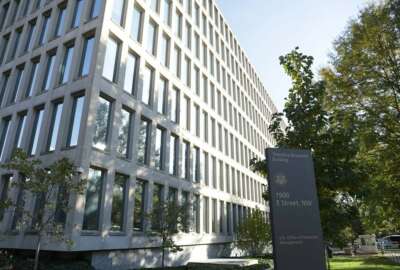The administration’s DEI leader brings experience from work at the state level
Anyone working in the last few years has likely encountered the DEI movement: diversity, equity and inclusion. The Biden administration expanded that by adding an...
Anyone working in the last few years has likely encountered the DEI movement: diversity, equity and inclusion. The Biden administration expanded that by adding an “A” for accessibility. For more on this, Federal Drive with Tom Temin talked with Janice Underwood, who led DEI in the Commonwealth of Virginia, before becoming the top DEIA director at the Office of Personnel Management. Now she’s a new fellow at the National Academy of Public Administration.
Interview Transcript:
Tom Temin Let’s start with with the job itself. I’m not certain exactly what a DEI officer does or what the director of the DEIA, as the administration calls it. You’ve had accessibility. What do you do actually in that job?
Janice Underwood I love that question, Tom, and I’m so pleased to be with you. The role of government wide Chief diversity officer is a relatively new role and is a come out of executive order 14035 or the DEIA in the federal workforce, executive order as a outgrowth of the U.S. Chief Diversity officer, is executive council. And so I provide support to all of the chief diversity officers in our federal agencies, whether they’re in department agencies or subcomponent agencies. But as the administration has prioritized DEIA, my team for which I am the director of ODEIA at OPM, we provide external support to all of the federal agencies. So I’m not the chief diversity officer for OPM, but what I am is sort of the chief diversity officer for everyone else. Specifically, we provide technical assistance to agencies that are creating and or evaluating their progress for their DEIA strategic plans. I manage and supervise a DEIA learning community where I put top thought leaders and provide opportunities for the federal workforce to learn innovation as it relates to DEIA principles and do things like manage our various reporting, for example. I’m really excited to share that our OPM FEVS data has come out, and we are tracking our DEIA index. We set a baseline at 69% in 2022, and my job is to increase that baseline by six points by 2026.
Tom Temin And for a variety of reasons, organizations large and small and in the public sector, in the private sector, kind of rushed in with DEI programs during the aftermath of George Floyd. And all this happened during the pandemic. It was kind of a mixed up time for the nation, I think, in many ways. But what are the proper elements generally that make up a useful DEI program in the first place?
Janice Underwood I really appreciate that question, and I just want to sort of pause here to say that, you know, this work needs to be done by people who have expertise in understanding how to transform organizations to be more effective, understanding theoretical frameworks in the practical applications of them, such as change management frameworks and organizational development, have a background also in learning and training so that we are actually contributing to the improvement and sustainment of our organizations. This is not something and this is not work that I recommend people do just because they have a passion for principles DEIA. I have a passion for balancing my checkbook, but no one’s hiring me to be a CFO, right? And so just because you may have volunteered, for example, on a project or a special emphasis program or in an ERG, doesn’t in and of itself make you a highly qualified chief diversity officer in the private sector or public sector. And so this work really needs to be work that people have a background in data and accountability to understand how we move organizations from good to great, and specifically how we move our organizations across the maturity model that we’ve put out for agencies to use in the government wide strategic plan for the DEIA. There are three steps that we want our federal agencies to move on and to move through. The initial step is like a compliance sort of starting at the ground zero. But we ultimately want agencies to move to step two, which is called advancing. And then, of course, step three, which is called sustaining. And step three is sort of the gold standard or the platinum standard where agencies are engaging in promising practices that can be used as exemplars for other agencies, where they can begin to coach and support other agencies. And in getting to that that sustaining, leading and sustaining phase. So we want people, highly qualified people, not just people with passion or an interest, but people who understand how to use data, people who understand how to support the development of organizations and solve problems. DEIA is about thinking strategically, about employee experience and how that relates to customer experience. How do we improve organizational health of our organizations and how do we also increase equal opportunity for all?
Tom Temin We’re speaking with Dr. Janice Underwood. She’s director of the Office of Diversity, Equity, Inclusion and Accessibility at the Office of Personnel Management. And I guess the second question is, once you have those elements in place, compliance and I guess government in some ways has been exemplary for decades in compliance with the idea of everybody having equitable access to jobs and so forth. The practice may not be the same, but at least the compliance measures have been in place. How do you measure whether you are getting better at DEIA?
Janice Underwood Well, I alluded it to this measure or metric as we think about our OPM FEVS data, our Federal Employee Viewpoint survey, and I want all the listeners to know that we were thinking about how do you measure success? Because what we know for sure is you can’t change what you don’t measure and you won’t measure that what you don’t acknowledge. And so what we have done is we’ve acknowledged that desire is a priority. So we have developed questions for all four of the letters, the D, the E, the I, and the A. And we have created what’s called a DEIA index. And we have surveyed 1.6 million of our civilian employees. And what we’ve learned is that their perceptions are relatively positive to the questions related to all four letters. We created that baseline, as I mentioned earlier, at 69%, which makes me know that 69% generally have positive perceptions about DEIA. And this index will be used to really benchmark our progress going forward. We just released our 2023 data and what we saw was an increase in our desire index. And so we’re really pleased to see that government wide, our fellow federal employees have generally a very positive or increasing lead positive viewpoint of DEIA, according to our index. That is one of our major measurements, but also our maturity model. We will be measuring agencies and their growth and progress using the maturity model that’s located in the government wide strategic plan for DEIA. And all of our agencies created assessments and did their individual agency assessments in 2021 and have submitted their DEIA plans. All of the agencies that are required to do so under EO 14035 submitted them. And so now they’re in the implementation phase. Now what are we doing about it? How are we going to meet our goals? But let me be also clear, Tom. Every agency doesn’t have identical goals because every agency’s mission is different. And so agencies had the autonomy to create their own plans and think about their own goals, and now they’re implementing them and starting to track their progress. So we certainly want to understand the progress they’re making, and my office exists to support them in that journey.
Tom Temin Now you come to this job having done a similar job statewide in the Commonwealth of Virginia, and maybe discuss a little bit of the experience there, what you learned, what some of the outcomes were that you took to Washington crossing the river?
Janice Underwood Yes. So in 2019, former Governor Ralph Northam appointed me as the nation’s first cabinet level chief diversity officer. This was the first position of its kind to exist to a governor’s cabinet and serve in a secretary level role. Since leaving that role, what I learned was that we get a lot more done together and as not in silos. And so I was honored to support six other states to create a similar position in their governor’s office. But while I was in the Commonwealth of Virginia in this amazing role, working for an amazing administration. We created what’s called the One Virginia plan. And this effort truly did unite our state on our one Virginia mission, which is to create a state where everyone feels welcome to live, learn, visit, work and thrive. And so we really, really, really dug deep into that mission and brought together people who agreed with one another, disagreed with one another, were politically diverse, culturally diverse and diverse in so many other dimensions of diversity. Brought everyone together and said, how can we move together as a state? And as a result of that, we came up with the one Virginia plan, the first statewide strategic plan for DEI, and linked it to our entire racial equity agenda for the North administration. So in that role, I was able to lead the equity accomplishments across all secretariats and really think about it from the perspective of making Virginia the best state come work live, raise a family. And by the way, Tom, because of our DEI strategy, we won best state for which to do business three years in a row. One of those years was during COVID. And so CNBC did not publicize their rankings. But our last ranking in 2021 was specifically because of our equity driven innovation. So, so many lessons learned. And I’ll just also share with you, we learned that it’s so important to think about these things as part of a holistic strategy and not just a one and done not just because of the racial reckoning of 2020. Did we start this racial equity journey in Virginia. We started that racial equity in that racial reckoning in 2019, long before the summer of 2020, because Virginia was going through its own sort of racial reckoning, crisis and coming to understand the 1619 project in the true history of the common of Virginia, not the Commonwealth of Virginia, but just understanding the history. And so we codified that position, Tom, as a permanent Cabinet level position to serve every future governor. We codified the fact that all state agencies and universities had to report a DEI plan to the governor and to the Virginia chief diversity officer. And that legislation and that sort of part of the role still exists today across administrations.
Tom Temin And just to get back to the more parochial, earlier, you mentioned tying the DEIA at the federal level with customer experience. And just as a final question, maybe tie that loop for us.
Janice Underwood Well, what we know is that DEIA is all about building a better workforce for the American people. It’s what I’ve said since I came on in 2022, and it’s what I go around the nation talking about. I’m sort of as the face of DEIA. And what I mean by that is we have to build our internal federal workforce because we serve you, the American people. And if we want to increase customer experience with every facet of where the American people connect with the federal government, we have to make sure that we’re taking care of our workforce, because our number one job in public service is to serve the American people. And so we can’t do that unless we have a innovative well taking care of a highly trained workforce. And so that’s where DEIA comes in and so proud to do this work.
Tom Temin And by the way, you are, of course, a new NAPA inductee, a fellow at the National Academy of Public Administration. So I can kind of guess what issues you’re going to be working on there.
Janice Underwood Absolutely. And so I am super excited to be inducted as one of the 2023 fellows. I’m excited also and energized to be part of the social equity standing panel. But Tom, I’ve been working with that panel as a volunteer for the last couple of years now. Well, what I will tell you and this is what I told Terry Guertin and all others, is that principles of social equity and DEIA racial equity, all of these concepts, these principles of democracy, by the way, actually belong in all of the major challenges that NAPA is addressing. And so particularly, let me give you an example. I’m excited to start really digging my feet into the ethical uses of AI in the equity implications that are emerging with the increased conversations about AI because these are conversations that belong in all of the standing panels, in all of the conversations across all the grand challenges, and so excited to be part of the NAPA family.
Copyright © 2025 Federal News Network. All rights reserved. This website is not intended for users located within the European Economic Area.
Tom Temin is host of the Federal Drive and has been providing insight on federal technology and management issues for more than 30 years.
Follow @tteminWFED






